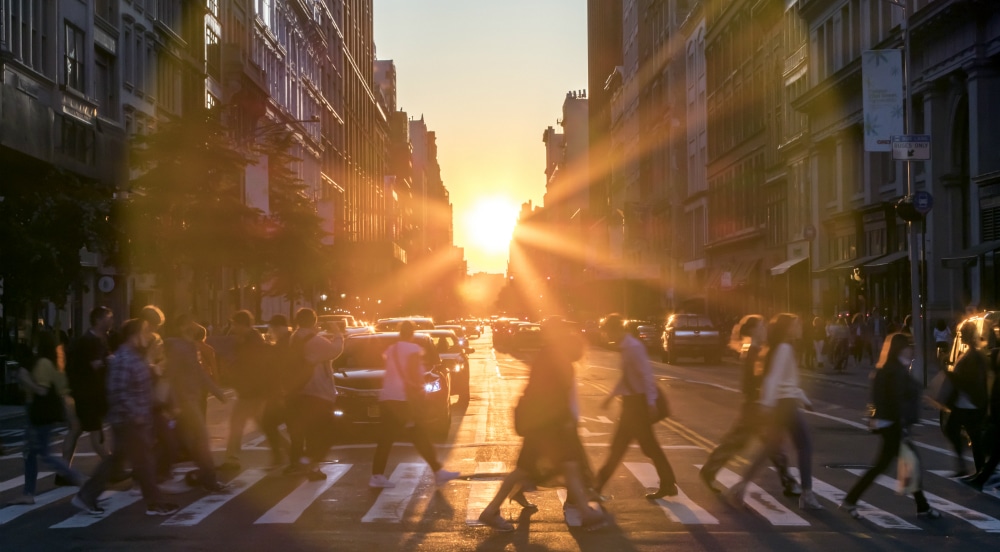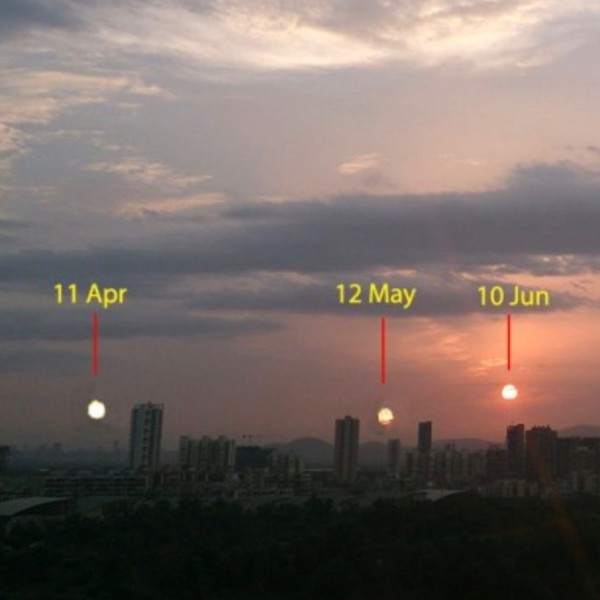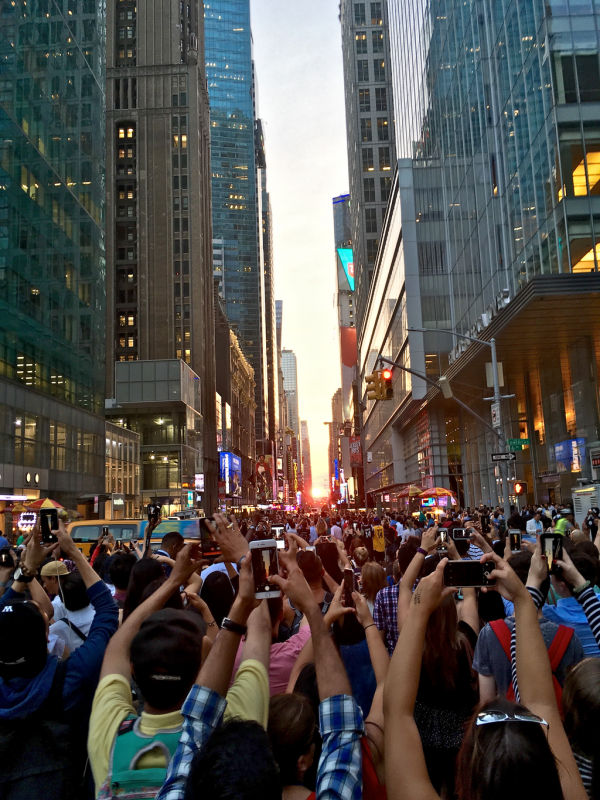
Every year around May 29 and 30 – and again around July 11 and 12 – people in New York City look forward to Manhattanhenge. It’s a phenomenon where the sunset aligns perfectly with east-west numbered streets of Manhattan, particularly along 42nd, 34th and 14th Streets. If you’re in the New York City area, think photo opportunity.
The 2nd set of this year’s Manhattanhenge dates start this weekend. The full sun will be visible on the NYC street grid on Sunday, July 11, 2021, at 8:20 p.m. EDT, and the half sun will be visible on Monday, July 12, at 8:21 p.m. EDT.
d
The phenomenon of Manhattanhenge is fun, one of similar alignments that occur around the world on various dates. Think Stonehenge at the equinoxes and solstices. The point of sunset along the horizon varies throughout the year. At this time of year – between the March equinox and June solstice – the sunset point is shifting northward each day on the horizon, as seen from around the globe. It’s the northward-shifting path of the sun that gives us summer in the Northern Hemisphere and winter in the Southern Hemisphere. And it’s the shifting path of the sun that gives people various alignments of the sunset with familiar landmarks.

Where to see Manhattanhenge
You can observe Manhattanhenge from lots of different places on the east-west streets of the Manhattan street grid. The best places to watch Manhattanhenge are wide streets with an unobstructed view toward New Jersey across the Hudson River. You can also choose to get your favorite of the city’s iconic buildings in your view. A popular spot is 34th Street near the Empire State Building, and 42nd Street near the Chrysler Building. Wide cross streets – such as 14th, 34th, 42nd and 57th Streets – that ensure the best views of the west-northwest horizon (toward New Jersey) are generally good spots.
Keep in mind – especially during these Covid times – that Manhattanhenge draws large crowds, especially around the city’s landmarks.
Why does Manhattenhenge happen?
The June solstice on June 21 will bring the sun’s northernmost point in our sky and northernmost sunset. Afterward, the sun’s path in our sky, and the sunset point, will both start shifting southward again. As for the sun’s alignment with the city of New York, and the streets of Manhattan Island … well, thank the original planners of this city. Scientific American explained:
The phenomenon is based on a design for Manhattan outlined in The Commissioners’ Plan of 1811 for a rectilinear grid or “gridiron” of straight streets and avenues that intersect one another at right angles. This design runs from north of Houston Street in Lower Manhattan to just south of 155th Street in Upper Manhattan. Most cross streets in between were arranged in a regular right-angled grid that was tilted 29 degrees east of true north to roughly replicate the angle of the island of Manhattan.
And because of this 29-degree tilt in the grid, the magic moment of the setting sun aligning with Manhattan’s cross streets does not coincide with the June solstice but rather with specific dates in late May and early July.


Read more about Manhattanhenge from ScientificAmerican.com
Bottom line: Each year on May 29 and 30, New Yorkers watch for Manhattanhenge. Here’s what causes it. Best Manhattanhenge dates and times for 2021.
The post Last chance to see Manhattanhenge in 2021 first appeared on EarthSky.
from EarthSky https://ift.tt/3fSzbeb

Every year around May 29 and 30 – and again around July 11 and 12 – people in New York City look forward to Manhattanhenge. It’s a phenomenon where the sunset aligns perfectly with east-west numbered streets of Manhattan, particularly along 42nd, 34th and 14th Streets. If you’re in the New York City area, think photo opportunity.
The 2nd set of this year’s Manhattanhenge dates start this weekend. The full sun will be visible on the NYC street grid on Sunday, July 11, 2021, at 8:20 p.m. EDT, and the half sun will be visible on Monday, July 12, at 8:21 p.m. EDT.
d
The phenomenon of Manhattanhenge is fun, one of similar alignments that occur around the world on various dates. Think Stonehenge at the equinoxes and solstices. The point of sunset along the horizon varies throughout the year. At this time of year – between the March equinox and June solstice – the sunset point is shifting northward each day on the horizon, as seen from around the globe. It’s the northward-shifting path of the sun that gives us summer in the Northern Hemisphere and winter in the Southern Hemisphere. And it’s the shifting path of the sun that gives people various alignments of the sunset with familiar landmarks.

Where to see Manhattanhenge
You can observe Manhattanhenge from lots of different places on the east-west streets of the Manhattan street grid. The best places to watch Manhattanhenge are wide streets with an unobstructed view toward New Jersey across the Hudson River. You can also choose to get your favorite of the city’s iconic buildings in your view. A popular spot is 34th Street near the Empire State Building, and 42nd Street near the Chrysler Building. Wide cross streets – such as 14th, 34th, 42nd and 57th Streets – that ensure the best views of the west-northwest horizon (toward New Jersey) are generally good spots.
Keep in mind – especially during these Covid times – that Manhattanhenge draws large crowds, especially around the city’s landmarks.
Why does Manhattenhenge happen?
The June solstice on June 21 will bring the sun’s northernmost point in our sky and northernmost sunset. Afterward, the sun’s path in our sky, and the sunset point, will both start shifting southward again. As for the sun’s alignment with the city of New York, and the streets of Manhattan Island … well, thank the original planners of this city. Scientific American explained:
The phenomenon is based on a design for Manhattan outlined in The Commissioners’ Plan of 1811 for a rectilinear grid or “gridiron” of straight streets and avenues that intersect one another at right angles. This design runs from north of Houston Street in Lower Manhattan to just south of 155th Street in Upper Manhattan. Most cross streets in between were arranged in a regular right-angled grid that was tilted 29 degrees east of true north to roughly replicate the angle of the island of Manhattan.
And because of this 29-degree tilt in the grid, the magic moment of the setting sun aligning with Manhattan’s cross streets does not coincide with the June solstice but rather with specific dates in late May and early July.


Read more about Manhattanhenge from ScientificAmerican.com
Bottom line: Each year on May 29 and 30, New Yorkers watch for Manhattanhenge. Here’s what causes it. Best Manhattanhenge dates and times for 2021.
The post Last chance to see Manhattanhenge in 2021 first appeared on EarthSky.
from EarthSky https://ift.tt/3fSzbeb

Aucun commentaire:
Enregistrer un commentaire